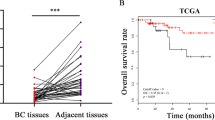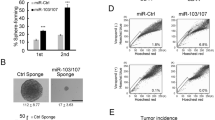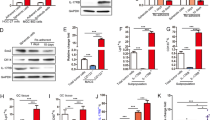Abstract
Accumulating evidence indicates that a sub-population of cancer cells with stem-like properties, termed tumor-initiating cells (T-ICs), exist in many different kinds of malignancies, which have a pivotal role in tumorigenesis, tumor progression, metastasis and post-treatment relapse. However, how the stem-like properties of T-ICs are regulated remains obscure. Our previous study showed that reduction of let-7 microRNA (miRNA) in breast tumor-initiating cells (BT-ICs) contributes to the maintenance of their self-renewal capacity and undifferentiated status. In this study we show the effect of mir-30 reduction on the stem-like features of BT-ICs. Similar to let-7, mir-30 is reduced in BT-ICs, and the protein level of Ubc9 (ubiquitin-conjugating enzyme 9) and ITGB3 (integrin β3), the target genes of mir-30, is markedly upregulated. Enforced constitutive expression of mir-30 in BT-ICs inhibits their self-renewal capacity by reducing Ubc9, and induces apoptosis through silencing ITGB3. On the contrary, blocking the miRNA with a specific antisense oligonucleotide (ASO) in differentiated breast cancer cells revived their self-renewal capacity. Furthermore, ectopic expression of mir-30 in BT-IC xenografts reduces tumorigenesis and lung metastasis in nonobese diabetic/severe combined immunodeficient mice, whereas blocking mir-30 expression enhances tumorigenesis and metastasis. Together, our data suggest mir-30 as one of the important miRNAs in regulating the stem-like features of T-ICs.
This is a preview of subscription content, access via your institution
Access options
Subscribe to this journal
Receive 50 print issues and online access
$259.00 per year
only $5.18 per issue
Buy this article
- Purchase on Springer Link
- Instant access to full article PDF
Prices may be subject to local taxes which are calculated during checkout




Similar content being viewed by others
References
Al-Hajj M . (2007). Cancer stem cells and oncology therapeutics. Curr Opin Oncol 19: 61–64.
Al-Hajj M, Wicha MS, Benito-Hernandez A, Morrison SJ, Clarke MF . (2003). Prospective identification of tumorigenic breast cancer cells. Proc Natl Acad Sci USA 100: 3983–3988.
Chen CZ . (2005). MicroRNAs as oncogenes and tumor suppressors. N Engl J Med 353: 1768–1771.
Cho RW, Clarke MF . (2008). Recent advances in cancer stem cells. Curr Opin Genet Dev 18: 48–53.
Croce CM, Calin GA . (2005). miRNAs, cancer, and stem cell division. Cell 122: 6–7.
Dalerba P, Cho RW, Clarke MF . (2007). Cancer stem cells: models and concepts. Annu Rev Med 58: 267–284.
Dalerba P, Clarke MF . (2007). Cancer stem cells and tumor metastasis: first steps into uncharted territory. Cell Stem Cell 1: 241–242.
Dontu G, Abdallah WM, Foley JM, Jackson KW, Clarke MF, Kawamura MJ et al. (2003). in vitro propagation and transcriptional profiling of human mammary stem/progenitor cells. Genes Dev 17: 1253–1270.
Gilmore AP . (2005). Anoikis. Cell Death Differ 12 (Suppl 2): 1473–1477.
Glinsky GV, Berezovska O, Glinskii AB . (2005). Microarray analysis identifies a death-from-cancer signature predicting therapy failure in patients with multiple types of cancer. J Clin Invest 115: 1503–1521.
Gupta PB, Chaffer CL, Weinberg RA . (2009). Cancer stem cells: mirage or reality? Nat Med 15: 1010–1012.
Ji Q, Hao X, Zhang M, Tang W, Yang M, Li L et al. (2009). MicroRNA miR-34 inhibits human pancreatic cancer tumor-initiating cells. PLoS ONE 4: e6816.
Jordan CT, Guzman ML, Noble M . (2006). Cancer stem cells. N Engl J Med 355: 1253–1261.
Mizejewski GJ . (1999). Role of integrins in cancer: survey of expression patterns. Proc Soc Exp Biol Med 222: 124–138.
Mo YY, Yu Y, Theodosiou E, Ee PL, Beck WT . (2005). A role for Ubc9 in tumorigenesis. Oncogene 24: 2677–2683.
Muller S, Hoege C, Pyrowolakis G, Jentsch S . (2001). SUMO, ubiquitin's mysterious cousin. Nat Rev Mol Cell Biol 2: 202–210.
Park SW, Hu X, Gupta P, Lin YP, Ha SG, Wei LN . (2007). SUMOylation of Tr2 orphan receptor involves Pml and fine-tunes Oct4 expression in stem cells. Nat Struct Mol Biol 14: 68–75.
Ponti D, Costa A, Zaffaroni N, Pratesi G, Petrangolini G, Coradini D et al. (2005). Isolation and in vitro propagation of tumorigenic breast cancer cells with stem/progenitor cell properties. Cancer Res 65: 5506–5511.
Pontier SM, Muller WJ . (2009). Integrins in mammary-stem-cell biology and breast-cancer progression—a role in cancer stem cells? J Cell Sci 122: 207–214.
Watanabe M, Takahashi K, Tomizawa K, Mizusawa H, Takahashi H . (2008). Developmental regulation of Ubc9 in the rat nervous system. Acta Biochim Pol 55: 681–686.
Wu F, Zhu S, Ding Y, Beck WT, Mo YY . (2009). MicroRNA-mediated regulation of Ubc9 expression in cancer cells. Clin Cancer Res 15: 1550–1557.
Yu F, Yao H, Zhu P, Zhang X, Pan Q, Gong C et al. (2007). let-7 regulates self renewal and tumorigenicity of breast cancer cells. Cell 131: 1109–1123.
Zhan M, Zhao H, Han ZC . (2004). Signalling mechanisms of anoikis. Histol Histopathol 19: 973–983.
Zhang Z, Liao B, Xu M, Jin Y . (2007). Post-translational modification of POU domain transcription factor Oct-4 by SUMO-1. FASEB J 21: 3042–3051.
Acknowledgements
This work was supported by the Natural Science Foundation of China Grant (30921140312, 30830110, 30772550, 30973396, 30525022, 30671930, 30973505), 973 (2010CB912800, 2009CB521706, 2005CB724605) Projects from the Ministry of Science and Technology of China, and Natural Science Foundation of Guangdong Province (8251008901000011).
Author information
Authors and Affiliations
Corresponding author
Ethics declarations
Competing interests
The authors declare no conflict of interest.
Additional information
Supplementary Information accompanies the paper on the Oncogene website
Supplementary information
Rights and permissions
About this article
Cite this article
Yu, F., Deng, H., Yao, H. et al. Mir-30 reduction maintains self-renewal and inhibits apoptosis in breast tumor-initiating cells. Oncogene 29, 4194–4204 (2010). https://doi.org/10.1038/onc.2010.167
Received:
Revised:
Accepted:
Published:
Issue Date:
DOI: https://doi.org/10.1038/onc.2010.167
Keywords
This article is cited by
-
Understanding crosstalk of organ tropism, tumor microenvironment and noncoding RNAs in breast cancer metastasis
Molecular Biology Reports (2023)
-
miR-30a targets STOX2 to increase cell proliferation and metastasis in hydatidiform moles via ERK, AKT, and P38 signaling pathways
Cancer Cell International (2022)
-
A 10-miRNA risk score-based prediction model for pathological complete response to neoadjuvant chemotherapy in hormone receptor-positive breast cancer
Science China Life Sciences (2022)
-
MicroRNA regulation of cancer stem cells in the pathogenesis of breast cancer
Cancer Cell International (2021)
-
Heterogeneity of BCSCs contributes to the metastatic organotropism of breast cancer
Journal of Experimental & Clinical Cancer Research (2021)



